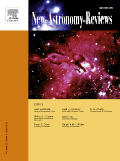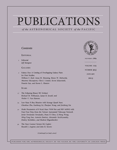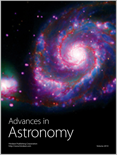
NEW ASTRONOMY REVIEWS
Scope & Guideline
Unveiling the Universe: Comprehensive Reviews for the Curious Mind
Introduction
Aims and Scopes
- Multi-Messenger Astronomy:
The journal focuses on the integration of different astronomical data sources, such as gravitational waves and electromagnetic radiation, to provide a holistic understanding of cosmic events. - Galactic and Stellar Evolution:
Research on the formation, evolution, and characteristics of galaxies and stars is a key area, with particular emphasis on observational data from missions like Gaia. - Dark Matter and Energy Studies:
The journal frequently publishes reviews on the latest findings and theoretical advancements in dark matter and dark energy, reflecting their crucial role in cosmology. - Exoplanet Research:
A significant focus is placed on the characterization and classification of exoplanets, including definitions and frameworks for understanding planetary systems. - Theoretical Astrophysics:
The journal includes discussions on theoretical models and frameworks that address complex phenomena such as black holes, gravitational waves, and cosmic structures.
Trending and Emerging
- Gaia Mission Insights:
Recent publications increasingly emphasize findings from the Gaia mission, particularly regarding stellar populations and galactic archaeology, showcasing the mission's transformative impact on our understanding of the Milky Way. - Gravitational Wave Astronomy:
There is a growing trend towards the exploration of gravitational wave detections, including their implications for astrophysical phenomena, signaling an expanding interest in this revolutionary field. - Black Hole Research:
Research surrounding black holes, particularly in the context of cosmic dawn and entropy variations, is gaining traction, reflecting increasing interest in the fundamental nature of these enigmatic objects. - Dark Matter Theories:
Theoretical advancements regarding dark matter, particularly through frameworks such as the Occam razor principle, indicate a renewed focus on resolving the mysteries of this elusive component of the universe. - Multi-Messenger Observations:
The integration of various observational strategies, such as the study of blazars through multi-messenger approaches, highlights an emerging trend towards collaborative methodologies in astronomical research.
Declining or Waning
- Meteor Showers Research:
There has been a noticeable decrease in publications focused specifically on meteor showers, suggesting a potential waning interest or a shift towards more complex astronomical phenomena. - Nucleosynthesis Studies:
While important, studies on nucleosynthesis in the context of novae and supernovae appear to be less frequently addressed in recent reviews, indicating a possible decline in focus on this area. - Jet Dynamics in Astrophysics:
Research related to jets from young stars and gamma-ray burst jets has become less prevalent, potentially overshadowed by more pressing topics like multi-messenger astronomy.
Similar Journals

PUBLICATIONS OF THE ASTRONOMICAL SOCIETY OF THE PACIFIC
Connecting Researchers to the Stars: Your Essential ResourcePublications of the Astronomical Society of the Pacific is a prestigious journal dedicated to advancing the fields of Astronomy and Astrophysics, as well as Space and Planetary Science. Published by IOP Publishing Ltd, this influential journal plays a critical role in disseminating groundbreaking research and innovative findings. With an impressive Q1 ranking in both related categories according to the 2023 metrics, it is recognized among the top journals in its field. As a vital resource for researchers, professionals, and students alike, the journal covers a range of topics relevant to current astronomical research from 1996 to 2024. Although it does not offer open access options, the journal is highly regarded in academic circles, evidenced by its competitive ranking in Scopus—20th in Astronomy and Astrophysics and 26th in Space and Planetary Science. This commitment to excellence ensures that it remains an essential platform for sharing the latest insights in the ever-evolving universe.

Bulgarian Astronomical Journal
Charting New Territories in Astronomical ResearchThe Bulgarian Astronomical Journal, published by the BULGARIAN ACADEMY OF SCIENCES, INSTITUTE OF ASTRONOMY, serves as a vital platform for the dissemination of research in the field of Astronomy and Astrophysics. With the ISSN 1313-2709 and E-ISSN 1314-5592, this journal has been pivotal in showcasing original studies and advancements in astronomical sciences from 2014 and will continue to do so through 2025. Although categorized in Q4 within the ambit of Astronomy and Astrophysics, it provides essential insights and innovative findings, making significant contributions to the global academic community. Positioned in the lower quartile of Scopus rankings, recognized as #87 out of 90, it offers an opportunity for burgeoning researchers and seasoned professionals alike to engage with emerging ideas and trends in the discipline. While it currently does not feature an open access model, readers and contributors can anticipate a rich exchange of scientific knowledge that fosters collaboration within the astronomy community.

Galaxies, published by MDPI, is a premier open-access journal dedicated to the vibrant field of Astronomy and Astrophysics. Established in 2013, with a strong commitment to making scientific research accessible, this journal has quickly garnered recognition, achieving a notable impact factor and ranking in the Q2 Quartile of its category as of 2023. With a Scopus ranking of #31 out of 90 in the domain of Astronomy and Astrophysics, and a commendable percentile rank of 66, Galaxies serves as a vital platform for researchers, professionals, and students engaged in astronomical studies and related fields, facilitating the dissemination and discussion of groundbreaking research. The journal covers a wide array of topics including galactic dynamics, cosmology, and observational astronomy, encouraging interdisciplinary collaboration and innovation within the scientific community. Located in Basel, Switzerland, and adhering to the highest publishing standards, Galaxies is committed to enriching the academic discourse in astronomy, making a significant impact on both current and future explorations of our universe.

Nature Astronomy
Advancing Astronomy: Your Gateway to Cutting-Edge Research and Discoveries.Nature Astronomy, published by NATURE PORTFOLIO, stands at the forefront of the field of Astronomy and Astrophysics. Since its inception in 2016, this esteemed journal has rapidly ascended to a prestigious position, achieving a Q1 ranking in the Astronomy and Astrophysics category and securing an impressive 6th place out of 90 journals in the Scopus rankings, placing it in the 93rd percentile. With a focus on disseminating pioneering research, Nature Astronomy provides a vital platform for the dissemination of high-quality, impactful findings across various aspects of astronomical science. Researchers, professionals, and students alike will find a wealth of knowledge and innovative perspectives within its pages, enabling them to stay ahead in a rapidly evolving field. Although it does not offer open access, the journal's commitment to excellence and its influence in shaping the future of astronomical research make it an indispensable resource for anyone serious about advancing their understanding of the cosmos.

Astrophysical Bulletin
Connecting Scholars to the Wonders of the UniverseWelcome to the Astrophysical Bulletin, an esteemed journal published by MAIK NAUKA/INTERPERIODICA/SPRINGER that has been contributing to the fields of Astronomy and Astrophysics since its inception in 2009. With a prominent Q3 rating in both Astronomy and Astrophysics and Instrumentation, this journal is designed to foster an understanding of astronomical phenomena through comprehensive research articles and groundbreaking discoveries. While currently not offering open access, it remains a vital resource for researchers and professionals looking to stay informed on the latest advances in the field, featuring a compelling selection of peer-reviewed studies that underscore its relevance and impact. The Astrophysical Bulletin ranks impressively in Scopus, making it a trusted platform for disseminating vital knowledge and new insights into our universe.

Journal of High Energy Astrophysics
Connecting Minds: Collaborations in High Energy AstrophysicsThe Journal of High Energy Astrophysics, published by Elsevier, is a premier platform for groundbreaking research in the fields of astrophysics and high-energy phenomena. With an ISSN of 2214-4048 and an E-ISSN of 2214-4056, this journal has quickly established itself as a leader since its inception in 2014. Operating out of the Netherlands, it is recognized for its rigorous peer-review process and high-quality publications, earning an impressive Q1 ranking across multiple domains, including Astronomy and Astrophysics, Nuclear and High Energy Physics, and Space and Planetary Science in 2023. With a Scopus rank of 12 out of 90 in the Astronomy and Astrophysics category, and being positioned in the 87th percentile, the journal plays a pivotal role in disseminating advancements and fostering collaboration among researchers, professionals, and students. Though the journal is not open access, it offers robust subscription options for institutions and individuals seeking to dive into the latest discoveries and theories in high-energy astrophysics.

Serbian Astronomical Journal
Engaging Minds in the Quest for Cosmic KnowledgeSerbian Astronomical Journal, published by the Astronomical Observatory Belgrade, serves as a significant platform for research and innovation within the field of astronomy and astrophysics. With an established publication history since 1992 and an Open Access model, the journal ensures that its cutting-edge research is accessible to a global audience. The journal is recognized for its contribution to the scientific community, evidenced by its solid position in the 2023 Scopus category quartiles, ranking Q3 in Astronomy and Astrophysics. This positions it among notable journals in the discipline, despite being at the 18th percentile of its category rankings. Researchers, professionals, and students will find in Serbian Astronomical Journal a valuable resource for disseminating findings, exploring new discoveries, and engaging with contemporary challenges in astronomy. As the journal continues to evolve, it remains dedicated to advancing the knowledge and understanding of the universe.

JOURNAL OF ASTROPHYSICS AND ASTRONOMY
Illuminating the Mysteries of the Universe.JOURNAL OF ASTROPHYSICS AND ASTRONOMY, published by the Indian Academy of Sciences, stands as a pivotal resource for researchers and professionals in the fields of astrophysics and astronomy, with a rich history of publication dating back to 1980. This esteemed journal aims to disseminate high-quality research, fostering advancements in how we understand celestial phenomena, space environments, and planetary sciences. With a current Impact Factor that places it in the Q3 category for both Astronomy and Astrophysics and Space and Planetary Science, it maintains a crucial role in the global academic community, particularly within India. Although not an open access journal, its scholarly contributions are vital for both emerging and established researchers striving to push the boundaries of our knowledge in the cosmos. The journal is indexed in Scopus, ranking 56th in Astronomy and Astrophysics and 72nd in Space and Planetary Science, reflecting its ongoing significance and reach in the scientific dialogue.

Physics of the Dark Universe
Exploring the Enigmatic Forces of the UniversePhysics of the Dark Universe is a premier academic journal published by Elsevier, dedicated to advancing the understanding of dark matter, dark energy, and their implications for the universe. With its ISSN N/A and E-ISSN 2212-6864, the journal has established a notable presence since its inception in 2012, operating out of Amsterdam, Netherlands. As evidenced by its impressive impact factor and its ranking in the top quartile in both Astronomy and Astrophysics (Q1) and Space and Planetary Science (Q1) categories for 2023, this journal is a vital resource for researchers and practitioners within these fields. In the latest Scopus ranks, it ranks #12 out of 104 in Earth and Planetary Sciences and #13 out of 90 in Physics and Astronomy, placing it in the 88th and 86th percentiles respectively, underlining its academic significance. The journal is not Open Access, yet it plays an essential role in disseminating high-quality research that pushes the boundaries of knowledge about the cosmos and its most enigmatic components. Researchers, professionals, and students interested in the forefront of astrophysics will find this journal an indispensable tool for staying abreast of emerging discoveries and ongoing debates.

Advances in Astronomy
Pioneering Research in Astronomy and Astrophysics.Advances in Astronomy is a prestigious open-access journal published by HINDAWI LTD, dedicated to the field of astronomy and astrophysics. Established in 2008, the journal aims to disseminate significant research findings and advancements in the understanding of celestial phenomena, planetary sciences, and the intricate workings of the universe. With an impact factor that reflects its relevance in the scholarly community, Advances in Astronomy holds a commendable rank of Q3 in both Astronomy and Astrophysics as well as Space and Planetary Science categories, indicating its importance within these fields. The journal also showcases a commitment to open-access publishing, ensuring that research is readily available to both the scientific community and the public. Researchers, professionals, and students alike are encouraged to contribute to this dynamic forum to share knowledge and foster collaboration in exploring the wonders of the cosmos.